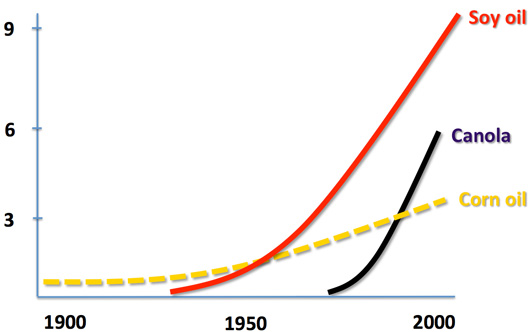
This information HAS errors and is made available
WITHOUT ANY WARRANTY OF ANY KIND and without even the
implied warranty of MERCHANTABILITY or FITNESS FOR A
PARTICULAR PURPOSE. It is not permissible to be read by
anyone who has ever met a lawyer or attorney. Use is confined to
Engineers with more than 370 course hours of engineering.
If you see an error contact:
+1(785) 841 3089
inform@xtronics.com
LA is the most common PUFA. LA has been promoted due to an effect of lowering cholesterol numbers. This has not been shown effective to reduce other end-points such as all-cause-mortality. Recent research has shown that LA induces inappropriate insulin sensitivity. This effect I think is beyond speculation. It is important to note that this is not part of the LA => AA theory about the dangers of PUFAs. What follows are speculations that are due to other metabolic pathways.
From 1960 on there has been a great increase in the consumption of LA. There is some significant correlations to consider. While correlations do not show causation - they do suggest the need for careful experiments to rule out the causation - these have not been done.
It is possible to get the LA content of adipose tissue via NMR. This level is an objective measure of LA exposure and correlations with obesity/T2D and other disease can be explored.


"The linoleic acid content of body fat has increased tremendously in the US over the last 50 years, as shown in the following graph, based on a number of different studies, each of which is represented by an orange dot
http://www.ncbi.nlm.nih.gov/pubmed/1130317
http://www.ncbi.nlm.nih.gov/pmc/articles/PMC1216266/
http://www.ncbi.nlm.nih.gov/pubmed/3728359
http://www.ncbi.nlm.nih.gov/pubmed/1858698
http://www.ncbi.nlm.nih.gov/pubmed/9440371
http://www.ncbi.nlm.nih.gov/pubmed/12559671
http://www.ncbi.nlm.nih.gov/pmc/articles/PMC2515528/
" I also included a study that looked at the linoleic acid content of chimpanzee fat, for reference
http://www.ncbi.nlm.nih.gov/pmc/articles/PMC1216266/ "The caveat is that the paper doesn't specify if the chimp was
captive or wild, so you can take it with a grain of salt.
Linoleic acid in human breast milk has also increased quite a bit
over the same time period


LA has an approximate 600-day half-life in adipose tissue by some accounts, thus changes in diets are not going to show sudden changes in weight in a way that people would see a cause connected to an effect - the same problem with research.
There are some papers that show a blocking activity of lipogenic enzymes.
| Top Page | wiki Index |
(C) Copyright 1994-2019
All trademarks are the property of their respective owners.